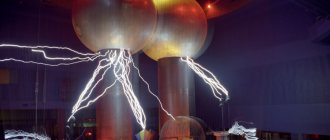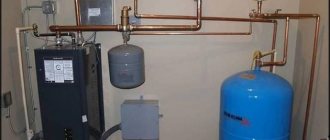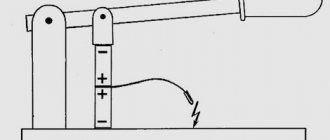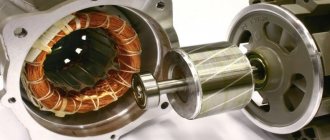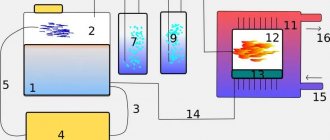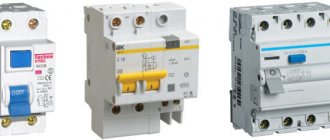When is a home generator useful?
Electric generators are most often used in emergency situations. When the power supply to the site is interrupted, it is enough to remove this unit from the garage and start it to temporarily restore the power supply.
Many people consider such a device to be an unnecessary luxury. However, in populated areas where the power supply is often interrupted or during an emergency, a generator can help out.
Types of generators by starting method
The generator is started in several ways:
- Manual. To start, use a starting cord, the pull of which sets the engine mechanism in motion. A simple, reliable method that requires physical effort, which is unattractive for frequent launches.
- Electric. Starting is carried out by pressing a button on the unit or control panel. Effective with frequent and emergency use.
- Auto. Does not require human presence. Triggers independently when the power supply is cut off.
Principle of operation
An electric generator is a device for generating electricity. It can be used to power electrical devices.
- An electric generator can power devices in a private home during a power outage.
- However, it can also be successfully used where it will be an independent source of electricity.
- Such places would be, for example, a garage, workshop, garden or construction site.
The best models with power up to 10 kW
Power plants with a capacity of up to 10 kW will confidently provide power to any household equipment in a small private house.
Hyundai HHY 10000FE ATS (7500 W)
The 7500 W Hyundai HHY 10000FE ATS power station is an ideal alternative power supply for low- and medium-power consumer devices in a country house.
The equipment is equipped with a professional four-stroke gasoline engine and an automatic output voltage regulation system.
The power unit is characterized by low fuel consumption.
The generator sockets are equipped with protective covers with a self-returning mechanism that prevents dust and moisture from getting inside.
The power plant has effective protection against overload and short circuit; when the oil level is low, a special emergency module is triggered.
Specifications:
- rated power - 7.5 kW;
- starting system - manual, electric, auto;
- number of phases - 1 (220 V);
- sockets - 1×220 V, 1×12 V;
- fuel tank capacity - 25 l;
- engine capacity - 460 cubic meters. cm;
- features - muffler, overload protection, voltmeter, hour meter;
- dimensions and weight - 750x620x590 mm, 89.5 kg.
Advantages
- relatively quiet operation;
- stable operation;
- presence of automatic start;
- constant battery charge.
Flaws
- heavy weight;
- solid dimensions;
- one 220 V socket.
A-iPower A8500EA (8000 W)
The A-iPower A8500EA equipment with a rated power of 8000 W will become an inexpensive and compact source of constant or backup power in private households, helping to solve the problem of lack or irregular receipt of electrical energy.
The generator provides support for equipment that briefly consumes up to 8500 W during startup.
The unit with a full tank of fuel operates autonomously for up to 9.6 hours.
The station is equipped with a powerful 459 cc four-stroke engine. cm, has an electric starter, is equipped with a convenient control panel, three 220 V sockets, terminals for removing full power, and a USB port for charging mobile gadgets.
The digital display provides real-time information about the generator's performance.
Specifications:
- rated power - 8 kW;
- starting system - electric;
- number of phases - 1 (220 V);
- sockets - 3×220 V;
- fuel tank capacity - 40 l;
- engine capacity - 459 cubic meters. cm;
- features - overload protection, protection class IP23;
- dimensions and weight - 710x534x605 mm, 103.4 kg.
Advantages
- good assembly;
- decent equipment;
- three 220 V sockets;
- convenient display;
- capacious gas tank.
Flaws
- lack of wheels;
- heavy weight;
- high price tag.
Hyundai HHY 9020FE (6000 W)
The Hyundai HHY 9020FE model with a rated power of 6000 W is easy to operate and is suitable for backup or constant power supply of consumer devices in a private home/dacha.
The unit is equipped with a professional four-stroke gasoline engine and an automatic voltage regulator.
The station is distinguished by its economical fuel consumption.
The generator sockets have covers with a self-returning mechanism; the device is protected from overloads by an emergency stop system.
The power part is forcibly cooled by a fan. The noise level of operating equipment does not exceed 74 dB.
Specifications:
- rated power - 6 kW;
- starting system - manual, electric;
- number of phases - 1 (220 V);
- sockets - 2×220 V, 1×12 V;
- fuel tank capacity - 25 l;
- engine capacity - 420 cubic meters. cm;
- features - muffler, overload protection, voltmeter, hour meter;
- dimensions and weight - 730x600x570 mm, 85 kg.
Advantages
- high power;
- acceptable noise level;
- stable output voltage;
- easy starting in manual mode and electric starter.
Flaws
- not the most economical model;
- no wheels included;
- heavy weight.
Huter DY6500L (5000 W)
The Huter DY6500L electric generator with a rated power of 5000 W is an excellent option for providing backup or permanent power to equipment in private households.
The presented device runs on AI-92 gasoline. Its four-stroke engine is fuel efficient.
The battery life of the equipment is 10 hours. The generator produces a stabilized voltage of 220 V at the output.
Two single-phase sockets are convenient for powering various household devices. The equipment is protected by a powerful steel frame, which is also used as handles for carrying the device.
Specifications:
- rated power - 5 kW;
- starting system - manual;
- number of phases - 1 (220 V);
- sockets - 2×220 V;
- fuel tank capacity - 22 l;
- engine capacity - 389 cubic meters. cm;
- features - muffler, overload protection, voltmeter;
- dimensions and weight - 690x550x540 mm, 70 kg.
Advantages
- high build quality;
- good performance;
- relatively small size;
- low consumption of gasoline and oil.
Flaws
- hard start;
- lack of wheels;
- impressive weight.
Fuel type
The generator sets available in the market are most often equipped with an internal combustion engine. Some models can also run on liquefied or natural gas.
A petrol engine, like a car, may perform slightly better, but is theoretically less durable if the unit is used intensively.
When choosing a generator, you should also pay attention to the capacity of the fuel tank. It is related to working hours. It is also worth checking whether the generator has a fuel level sensor and a catalytic converter to reduce exhaust emissions.
How to count?
In order to correctly calculate the power and prevent the mobile power station from breaking down during operation, it is important to take into account every electrical appliance in the house, as well as think through all possible situations that may arise.
Thus, the preparatory stage is a complete accounting of all electrical appliances in the house. In order to conduct an inventory, you need:
1. Take a piece of paper and a pen.
2. Write down the electrical equipment used in the house. In this case, it is important to write the name of the device, and next to it - its power in kilowatts.
3. Write down the electrical equipment that you plan to purchase and use in the future.
After this, you will need to calculate the total power of the electrical appliances in use. During the inventory process, it is important to understand which electrical appliances are vital, and which ones will be used extremely rarely, and can be forgotten about during a power outage.
For example, lights and a refrigerator will be needed in the event of a power outage. The same can be said about the stove and kettle. Telephones, computers and other similar devices are no longer so important, so they can be classified as the second group of necessary devices.
The third group - the least necessary electrical appliances - consists of a vacuum cleaner, washing machine, iron and similar devices. It’s unlikely that anyone would want to suddenly go clean the carpet when the electricity suddenly goes out.
Additionally, during the calculation, it is recommended to pay attention to which electrical appliances will be connected to the generator at the same time, and which ones will be able to avoid the period of peak active power consumption.
The first stage is the sum of capacities
This stage involves calculating the sum of the powers of all electrical appliances used at the peak moment, that is, at the moment when electricity consumption is maximum. The coefficients for summation can be found in the operating instructions for electrical appliances.
The most popular electrical appliances are shown in the table:
| electrical appliance | power, kWt |
| Fridge | Up to 0.3 |
| TV | 0,1 |
| Washing machine | 1,4 |
| Microwave | 1 |
| Electric kettle | 2 |
| Vacuum cleaner | 0,8 |
| Iron | 1 |
| Incandescent lamp | Up to 0.1 |
Thus, looking at the table, calculating the approximate power of the devices in use is not so difficult. But the calculation of generator power does not end there.
Second stage - power reserve
When the approximate power from household appliances, appliances and other devices used in household appliances is determined, you will need to add another 20-30% to the result obtained. In this way, the power reserve is taken into account. This is necessary so that the operating mode of the power plant is as optimal as possible. This will also allow us to take into account the requirement that the acceptable load on the generator should not exceed 80% of its power.
To select the correct reserve, you must choose what exactly you plan to use the generator for. There are two possible use cases:
1. Generator as a backup power station in case of power outage. The most popular option, and here it will be enough to add only 10% instead of 20-30% to the resulting amount of device power.
2. Generator as a constant source of electricity. Quite a rare and inconvenient option. Here you will have to add 30%.
If you incorrectly calculate the power reserve, then during operation of the unit it may be overloaded. This will cause the device to malfunction and stop working.
Third stage - starting current coefficient
When calculating the power of a power plant, it is also important to take into account such an indicator as the starting current coefficient. This is the number by which the power of an electrical appliance is multiplied in standard operating mode. The need to take into account the coefficient is explained by the fact that when starting up equipment, it consumes more energy than when it operates for a long time.
Manufacturers often ignore this parameter, which subsequently causes generator failure. To provide for this point, the table shows the most popular electrical appliances, as well as their inrush current coefficients.
| electrical appliance | Starting current coefficient |
| TV | 1,0 |
| Music system | 1,0 |
| Electric stove | 1.0 |
| Electric oven | 1,0 |
| Microwave | 1,9 |
| Fridge | 3,5 |
| Vacuum cleaner | 1,2 |
| Air conditioner | 3,5 |
| Washing machine | 3,5 |
| Power tools for working with materials | 1,2-1,3 |
| Submersible water pump | >5,0 |
It is not difficult to calculate the new power; you need to multiply the standard indicator by a coefficient, and then the number will increase.
After three stages, the final result will be the required power for the future generator. When all the calculations have been completed, you can go to the store to purchase a unit with suitable power.
Generators with internal combustion engines
The most commonly used generators are powered by gasoline or diesel internal combustion engines.
The power of the unit depends on the engine size. It is better to choose a place for them where the engine noise will not bother you. It is desirable that it have a roof.
Power
The quality of generated electricity and the efficiency of the unit depend on this parameter:
- Less than 3 kW. Backup generators for powering important electrical equipment (refrigerator, water pump, heating boiler, etc.). They are represented by gasoline units that exclude constant operation.
- 3–5 kW. Transitional series, suitable for a summer residence. Such generators combine the functions of reserve and constant power supply to a limited number of electrical appliances.
- 5–7 kW. Generators designed to provide electricity to large country estates with a lot of electrical appliances.
- Over 10 kW. Electrical installations used in small businesses. They provide electricity to small supermarkets, production workshops, etc.
The choice of power generator depends on the total load. Devices up to 1.5 kW are designed for minimal power consumption. Two to three kilowatts are enough for lighting devices, TV and computer. Connecting a washing machine, electric stove and other household appliances requires power from a generator with a power of 3 kW or more.
Saving on power is not advisable. The voltage of an electric generator operating at its maximum capacity is unstable, the unit consumes more fuel, overheats and threatens to fail.
Single and three phase units
Single-phase generators require a voltage of 1~230V. These are low power devices. They are primarily suitable for household appliances. In turn, three-phase generators 3~400V are suitable for high-power equipment. These are mainly electric heating, hydrophore installations, water heaters, and so on.
- Before choosing a generator, it is also good to check what type of electricity the power comes from.
- There is also a more universal device - a three-phase generator, which also allows you to connect single-phase devices (it has 2 sets of sockets).
- However, such a unit should be used according to certain rules. The current power consumed from single-phase sockets cannot exceed 60% of the power of the entire generator.
- You should also ensure that when simultaneously supplying single-phase and three-phase loads, the phases are loaded more or less evenly.
The more powerful the generator, the more appliances you can power from it at the same time, but also the more money and space you will have to spend on it. Some models are very large. This is especially noticeable in the photo of a generator for the home.
Unit selection
When purchasing a generator, it is recommended to immediately decide for what purpose the installation is needed. If this is a backup power source, a minimum set of devices must be taken into account. To organize a completely autonomous system, you need to count all the devices and add at least 20% to them.
Work in winter
When choosing between gasoline and diesel units, the buyer must answer several questions:
- Number of phases.
- A type of engine starting for a particular situation.
- Acceptable noise level.
- Required power indicator.
- Expenses for purchasing the unit.
- Which manufacturer did you decide to trust? This is also important for non-electrical installations.
Generator types
A home generator produces power in a single-phase system, but three-phase generators can also be found.
Another criterion is the type of fuel used and the power generated by the device. The cheapest units are those with a two-stroke engine running on a mixture of gasoline and oil in certain proportions. Unfortunately, they are not very economical and are quite loud.
The best choice is a generator with a four-stroke internal combustion engine.
The least common devices on the market are natural gas generators.
- Their main advantage is that they can be powered from gas cylinders, so they are often used as an emergency power source on sites.
- Unfortunately, the gas itself is ineffective and burns strongly while the device is operating.
- However, if you need a very efficient generator that will be used frequently, you may want to look at a diesel generator.
TOP 3 best inverter generators
Inverter electric generators are in particular demand because they are affordable and ensure uninterrupted operation of various equipment. The range of well-known brands includes many models with different characteristics. The rating includes devices that, according to consumers, are the most practical to use.
PATRIOT GP 2000i
Compact inverter electric generator with optimal characteristics . Despite its small size, it can supply energy to several electrical appliances.
An indispensable device for a summer house, a country house, fishing and camping.
The model is equipped with an automatic voltage stabilizer, which eliminates engine damage.
Due to the powerful inverter motor and the special design of the device body, it produces minimal noise and vibration during operation. There is an ECO mode for economical fuel consumption.
Characteristics:
- tank volume - 3.6 l;
- fuel consumption - 1.2 l/h;
- generator weight - 18.5 kg;
- noise - 58 dB.
Advantages:
- compact size;
- powerful engine;
- easy operation;
- quick start.
Flaws:
- ill-conceived cooling system;
- poor quality muffler.
BISON ZIG-3500
The equipment generates up to 3 kW of energy to ensure stable operation of several household appliances . It is characterized by its small size and weight, making it convenient to operate and transport.
The housing is covered with a noise-insulating casing, which reduces noise levels and protects the devices from external influences.
Thanks to a high-quality motor, the generator can supply energy even to sensitive equipment.
Characteristics:
- engine power - 5.7 hp;
- tank volume - 5.7 l;
- fuel consumption - 1.2 l/h;
- generator weight - 30 kg;
- noise - 58 dB.
Advantages:
- compact size;
- powerful engine;
- quiet operation;
- affordable price.
Flaws:
- short operating time;
- only one socket on the body.
Fubag TI 2300
Compact and practical electric generator, suitable for connecting devices with a power of 2.3 kW . Suitable as an emergency source of power supply in a summer cottage.
An economical operating mode is provided when connecting a minimum amount of equipment.
The generator is equipped with a short circuit and overload protection system, as well as a noise-insulating casing and anti-vibration rubber feet.
Characteristics:
- engine power - 5.7 hp;
- tank volume - 3.8 l;
- fuel consumption - 1.2 l/h;
- size - 500x460x270 mm;
- generator weight - 23 kg;
- noise - 61 dB.
Advantages:
- compact size;
- affordable price;
- Voltage regulator;
- soundproof casing.
Flaws:
- low power;
- small tank.
Number of connected devices
In order for the energy generator to fulfill its task, its power must be greater than the total power of the devices that will be connected to it.
Rated (not maximum) power is important, especially when it is necessary to power devices with asynchronous motors that require high current, such as pumps or hydrophores.
- When determining the power of an electric generator for a home, you should add up the power of all the devices that you plan to power.
- It should be 70-80% of the generator power. However, this indicator may vary depending on the generator itself and the connected devices.
- It is worth studying this topic in more detail before purchasing.
- Typically, 1.2 kW is added to the power consumption of each device. The power reserve should be 20-30%.
- Otherwise, the power consumption may be too high and you will have to turn off several devices.
It is better not to connect single-phase and three-phase devices to a three-phase generator at the same time.
Also, if necessary, you can buy a generator for your home with automatic start.
Simple calculation example
For example, we can consider a situation where a refrigerator, lamps, TV and vacuum cleaner are used at the same time in the country. The first stage involves calculating the sum of the capacities of the electrical appliances in use.
In this case, the total power will be approximately 2 kW. The second stage, taking into account the power reserve, implies an increase in the resulting number by 10%, since the generator is used only to maintain electricity in the event of a power outage. This results in 2.2 kW. After this, you need to move on to the third stage, which requires taking into account the starting current coefficient. The final result will be 2.23 kW. Thus, you can purchase a generator with a power of 2.5-3 kW, and this will be enough.
Independently calculating the power of a future generator is not difficult if you know the power indicators of all electrical appliances in the house, and also take into account power reserves and the corresponding coefficient. However, calculations by specialists will help you get a more accurate result and better select a generator for your home or site.
The quieter the better
Which generator is best for home? There is no clear answer to this question. But another important parameter when choosing a device is the level of noise it creates, which is indicated in the specification.
If the generator is located outside the building, then the volume can still be tolerated.
- The situation is different, for example, in a garage. Unfortunately, most generators available on the market make a lot of noise, reaching levels of 90-98 dB during operation.
- For comparison, a passing motorcycle produces 95 dB.
- However, there are models of built-in units (unfortunately, correspondingly more expensive), in which the noise level is reduced to 65–75 dB (vacuum cleaner - 70 dB).
What can be connected to a low power generator?
Low-power generators (0.5-2 kW) are in greatest demand due to their relatively low cost, as well as the ability to connect a minimum list of consumers that require high reliability in power supply. With this choice for a home, the first place most often comes from connecting lighting (on average about 6 lamps), a heating boiler, and household appliances (refrigerator, iron, TV).
| 0.5 kW | 1-2 light bulbs, phone charger, laptop/light bulb and TV |
| 1 kW | 2-3 light bulbs, laptop, phone charger/refrigerator and 1-2 light bulbs/1-2 light bulbs and heating boiler (stabilizer required) |
| 2 kW | 3-4 light bulbs, boiler, laptop, refrigerator, phone charger, TV |
Photo of a generator for home
Device management options
- Manual start. This type of starting is most often used in low-power generators. In order to start the unit, you will need to strongly pull the cord/twist the handle/press the starter pedal. It must be admitted that this is quite inconvenient and will require considerable physical effort.
- Electric start. With this design, to start it will be enough to simply press a button on the panel.
- Autostart. In this case, when the mains power goes out, the generator will start automatically without operator intervention, and then turn off when power is restored with a set time delay. The only thing that needs to be taken into account for this version is that the automation will not work if the temperature is less than +5 ˚С, so it is necessary to either install the equipment in a heated container or in a heated room.



